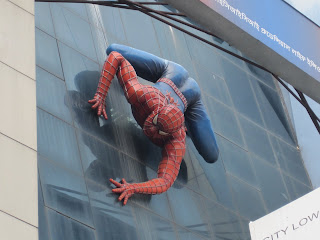
On Monday morning, we headed out to Asinsol by bus. The bus ride took about 3.5 hours, and after reaching Asinsol, we checked into our hotel. After freshening up and having a bit of brunch, we headed out via car to the village where our investigation was taking place. The drive, we were told, would take about an hour. Four hours later, we came to a halt inside the village. Three guesses as to a key reason for delay, and the first two don't count.
The village was very remote – we left paved road a good thirty minutes prior to actually getting inside the village, and most of the homes were without electricity.

One of the HRLN staffers who came on the trip, Miriam, was from Germany, and she was the only (visibly) non-Indian. I asked her later how she felt when she was in environments like this, but she brought up a good point – we all looked like foreigners to these villagers. Kolkata was far enough, let alone Delhi (or the US/Germany).
The first house we went to was that of Mukesh*. Mukesh was clearly a leader of sorts in the village, though there was nothing formalized about it. Mukesh and his wife laid out the background of the situation for us: Some time earlier, the local villagers had started a movement to make some changes in the village – going to the higher powers (state authorities, etc.) to try and get paved roads, etc. They were told over and over that these things would happen, but nothing happened. [This wasn’t exactly related to why we were there, but is in the way of providing a background for these villagers.] Most recently, the villagers had tried to close a liquor store that was located in a neighboring village – the purchasers of the alcohol were almost universally becoming drunk and then beating their wives/families, back in the village. Unsurprisingly, the liquor store owners did not take kindly to this movement. A group of villagers had gone from the village to the liquor store in order to explain their reasoning, and within a day or so, several of these villagers were picked up by the police.
The liquor store owners had not just stopped at complaining about the villagers’ interference – they claimed that these villagers were linked to the local
Maoist movement. Twelve villagers were arrested. When the rest of the village found out, they were upset about this – particularly as not all of those arrested were even those who had gone to the liquor store in the first place. The villagers gathered together, and decided to all go to the police station together and find out why the men had been arrested, and what they could do next.
Mukesh estimated roughly 500 people went to the police station. Upon entering the gates to the station, police officers came out of the station and without explanation or warning, began to beat the villagers. We documented dozens of injuries which were still apparent, nearly two weeks after the week –
bruises from
lathis, cuts from the bayonets

which are on police rifles (can I just say, WTF?? Police still carry bayonets??), marks from the rifles themselves. The police had beaten the villagers without discrimination: we talked to young men in their 20s, women in their 50s, and everything in between. The women were self-conscious about showing their injuries, often telling us to come back into their homes so they wouldn’t have to lift their skirt or turn their back out in the open. Some of the saddest moments were when the victims were convinced they had to have a huge mark on their arm or back given the amount of pain they still felt, but there was no visible evidence of the hit.
After all that, more villagers were arrested, many of whom were released later that night. Since the march/attack, which was on 12
th September, most of the arrested villagers had been released, but there were still 4 men in jail.
At this point, after taking dozens of pictures and speaking to several villagers, it had gotten late, and we needed to return to Asinsol for the night. We would be coming back the next day to make sure that we could speak to the families of the men who were still in jail, and make a plan for legal action against the police.
*Forgive me my paranoia.
 all, where else? We also had some delicious snacks, and a short visit to a famous Bengal confectioner's called Flurys. We then went on to do a bit of shopping and a lot of wandering around.
all, where else? We also had some delicious snacks, and a short visit to a famous Bengal confectioner's called Flurys. We then went on to do a bit of shopping and a lot of wandering around.  Karuna had promised to bring back some mithai for the office, so we stopped at a mithai shop and also tried a local specialty: mishti doi.
Karuna had promised to bring back some mithai for the office, so we stopped at a mithai shop and also tried a local specialty: mishti doi. all, where else? We also had some delicious snacks, and a short visit to a famous Bengal confectioner's called Flurys. We then went on to do a bit of shopping and a lot of wandering around.
all, where else? We also had some delicious snacks, and a short visit to a famous Bengal confectioner's called Flurys. We then went on to do a bit of shopping and a lot of wandering around.  Karuna had promised to bring back some mithai for the office, so we stopped at a mithai shop and also tried a local specialty: mishti doi.
Karuna had promised to bring back some mithai for the office, so we stopped at a mithai shop and also tried a local specialty: mishti doi.































